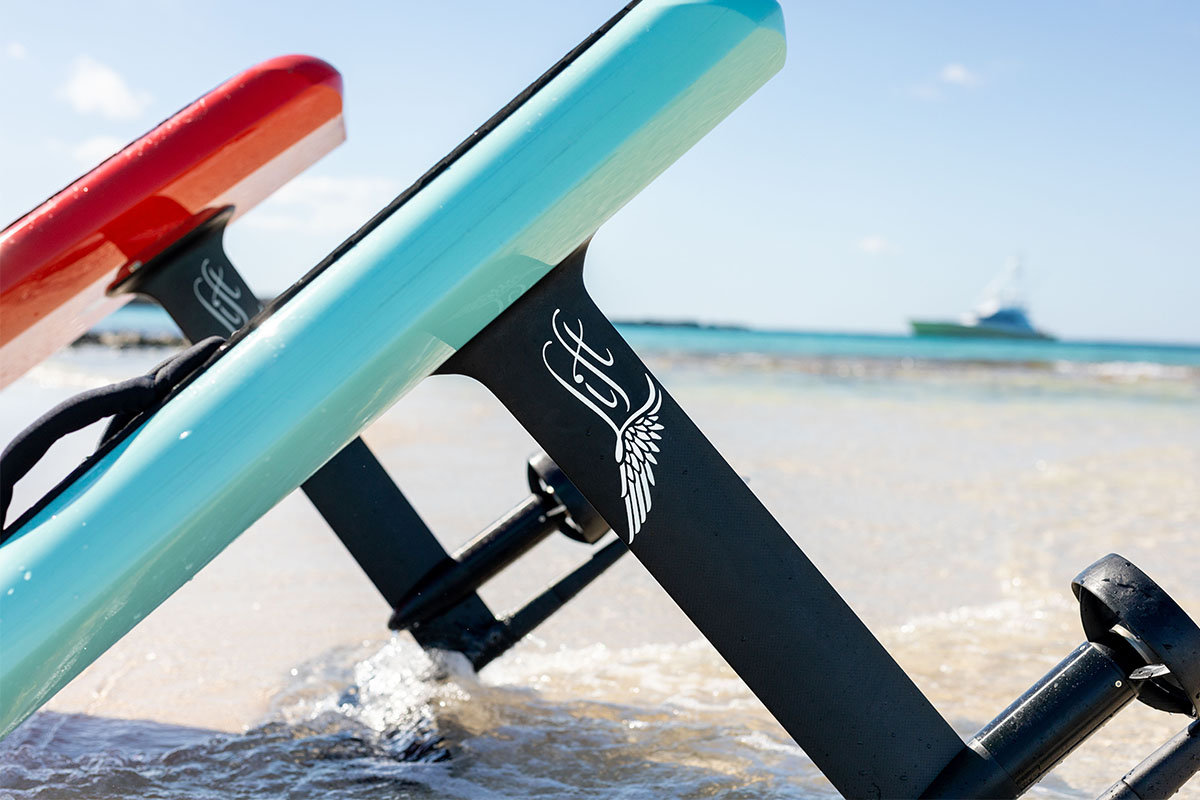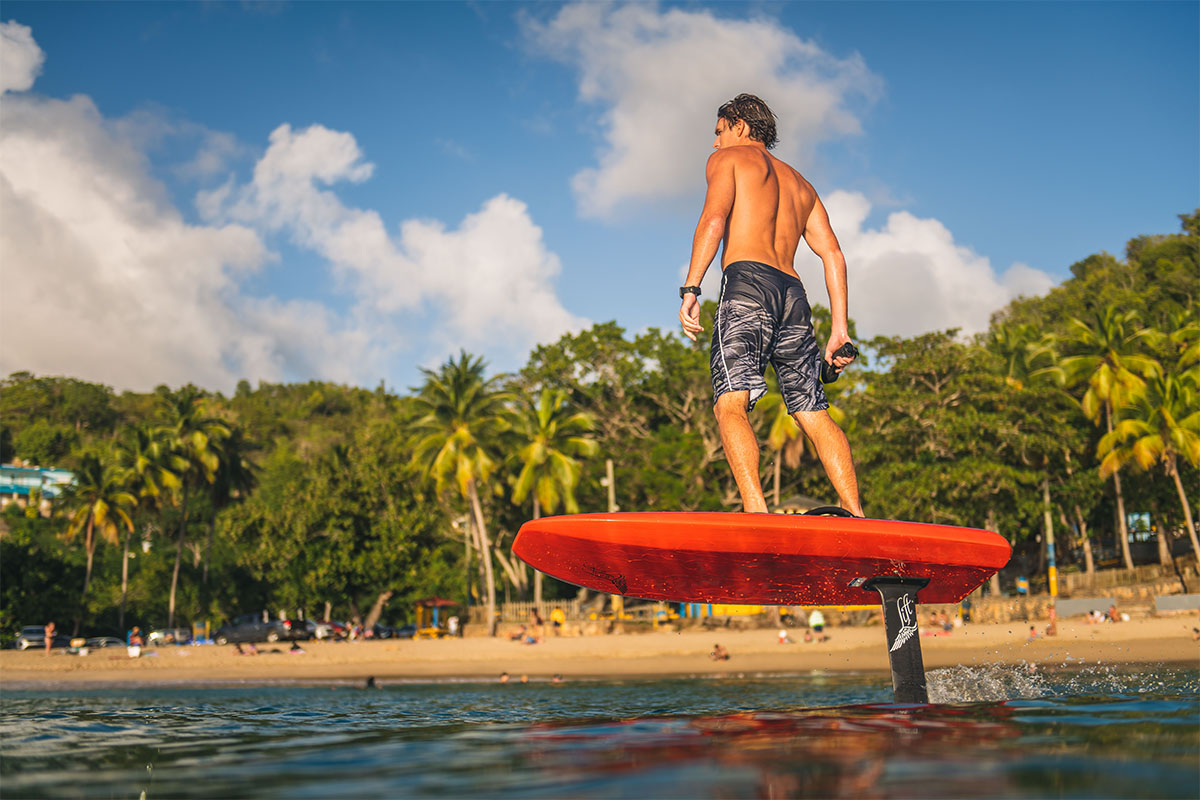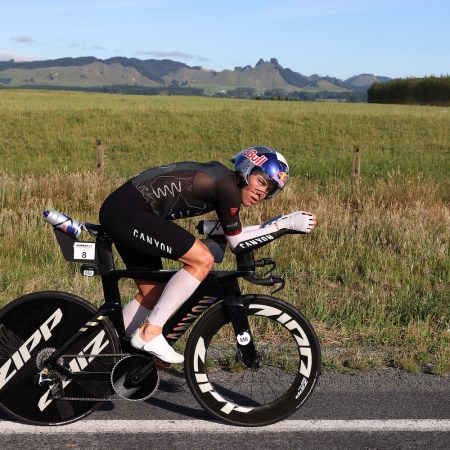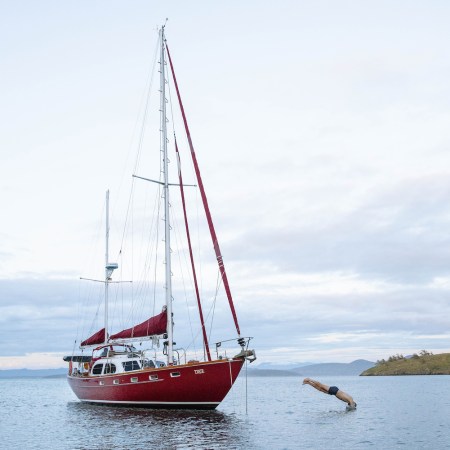Before taking my very first hydrofoiling lesson, I made the mistake of watching a video where a rider skims across the surface of a lake while playing around with a laptop. If people are out here sending emails from their foilboards, I reasoned to friends and family (the marketing charm somehow flying right over my head), I had little to worry about.
But negotiating an electric surfboard — of the sort now increasingly common in bays and beaches around the country — takes some doing. I learned that the hard, chilly way, during a 90ish-minute session in Southampton, New York last week, courtesy of Lift Foils, the Puerto Rico-based brand credited with developing the first electric-powered hydrofoil surfboard.
Lift’s board went into production back in 2018, the motorized, commercial culmination of years of foil dreams; the sport first found attention thanks to (who else?) tow-in legend Laird Hamilton, then reached another level of popularity after Kai Lenny started surfing shortboard with wings attached to the rocker. These days, a number of design labs now develop trigger-assisted “eFoils,” which can reach speeds above 30mph, and turn any relatively calm body of water into a water wonderland.
A sound bite from a recent promo for Habitas Bacalar, a Mexican wellness resort that Lift has a partnership with, perfectly sums up this theology. The retreat’s founder says: “When you’re foiling, and gliding above the water, you don’t hear an engine. You just hear nature, [you just see] this beautiful, pristine lagoon…you’re not even thinking any more. You’re flying. For me it’s more like yoga than an extreme sport.”
It’s a nice thought. But it certainly doesn’t describe my initial half hour on a hydrofoil.
I met Jeremy Stauffer at Cold Spring Pond on the bayside of Southampton. It’s an inlet a half mile from the Shinnecock Golf Club, ringed by dozens of homes — a few of them still salt-of-the-earth, most of them fit for a Succession cameo. We were the only ones out there on a Wednesday at lunchtime, on account of the staccato waves, the frosty water (temps were was somewhere in the 50s) and the fact that the area isn’t quite open for business yet this season.
Jeremy, a Jupiter, Florida native who charters boats along the Eastern Seaboard and is handling affiliate sales for Lift Foils in the Hamptons this summer, took us out on his Highfield 660 Patrol. He explained to me that a pair of LIFT3s, Lift’s latest model, had just arrived from Puerto Rico. He would be riding the 4’9” board, while I would be on the 5’9″, a better fit for beginners. When we finally dropped anchor at the far end of the pond, now closer to reeds, trees and duck blinds than any million-dollar docks, he pulled the tarps off each board and I got my first look at the unit: carbon fiber board, grippy platform, propulsion system, the infamous wing.
Before heaving the machine into the water, Jeremy gave me a trigger tutorial; I watched the tiny fan whir as he played with the throttle, and asked if anyone had ever gotten seriously injured on one of these things. He mentioned a “rumor” that someone might’ve lost a finger, and stressed the importance of falling off the back of the board, when possible. I swallowed. Woof.
I have some surfing experience, and am very comfortable on a skateboard, so I wasn’t too worried about balance or weight distribution. But electric foiling’s a different ballgame; it requires total cooperation between even your most innocent movements on the board, and your feel for the controller in your hand, a level of synergy that simply takes time…and a lot of blooper reel-worthy wipeouts. Yeah: I ate shit in a variety of spectacular ways throughout my demo, usually because I wasn’t standing close enough to the front of the board, or I shifted speeds on the throttle when I either should’ve held steady, or given the board more juice.
Fortunately, my teacher was patient, and in my ear throughout the entire lesson. We each wore helmets equipped with walkie talkies, which allowed us to jabber back and forth while out on the water. Jeremy coached me from the ground up, literally — I first had to master how to move with the eFoil, with my belly on the board. Once I found some semblance of consistency with that, it was time to raise myself to a kneeling position. From there, the endgame: standing tall, in a confident surfer’s stance.

It took me most of the first hour to reach this stage, at which point I felt like a wizard whilst zooming on my knees, if nothing else. There is a inflection point, speed-wise, where you know it’s time to move from your knees to your feet. Watching me from his board (where he was doing all sorts of fancy tricks; he might’ve been sending emails at one point) Jeremy would tell me exactly when to pounce. I was proud to realize, eventually, exactly when he was going to say it.
You should be moving quickly enough that the front of the board wants to plane, but is still slapping the water. Launching into a standing position when the board is hardly moving, meanwhile, is a guaranteed capsize.
I was so excited to be standing, the first time I stayed up there for more than 10 seconds, that I completely forgot the point of hydrofoiling — the whole foiling bit. The true endgame is in raising the board off the water, ever so gently, by tilting some of that weight to your back foot. Assuming you’re cooking along at a reasonable speed, not steering directly into a wave and avoiding the type of herky-jerky movement that could topple the whole operation, this is where the magic happens: the drag disappears, the board rises several feet into the air and the entire world goes silent.
I whooped and hollered like a madman the first few moments I experienced the sensation. I believe I screamed the words “This should be illegal!” into my microphone. Belated apologies to Jeremy’s ears. But I’ll double down on the assessment; foiling is a feeling as intoxicating as it is peaceful, rare and utterly bizarre. I can’t stay I managed to stay in this flow state (as Lift Foil’s co-founder, Nick Leason calls it), for too long. There’s a subconscious urge to up the throttle when you rise above the water, similar to opening it up on a wave runner when you only see ocean ahead, but that’s a surefire way to fall off. Instead, you want to keep the pace smooth and steady, and practice pushing your weight back to the front, to weather unwelcome bumps and keep your perch.
I learned this in my last few runs, before we both decided — a strong showing from the wetsuits notwithstanding — that we were too cold and ready for lunch. We zipped back to the boat, where I handed Jeremy my trigger. It was clinging to 75% battery; it’s supposed to last up to two hours on a charge. I’d somehow held onto it through every every spill, though it wouldn’t have mattered. It’s buoyant (and waterproof, as is every part of the board, even the interior battery pack). Taking my wetsuit off, I immediately appreciated how much of a workout foiling is. It would end up taking four days or so before the dull ache in my shoulders subsided. Those are beginner’s aches, though, to be clear. Vets don’t have to spend most of a session on their bellies, hanging on for dear life.
On the way back, Jeremy and I chatted about some of the incomprehensible wealth in the area. He mentioned boats with fuel changes that can cost up to $25,000. Electric-powered surfboards, make no mistake, belong to this world. They’re a rich person’s toy. The most accessible board on offer from Lift, the LIFT3F (which uses a fiberglass board instead of a carbon fiber one) will still run you $10,000. You don’t have to own one, though: Jeremy, for instance, plans to take parties of two out for introductory demos this summer, at a rate of $600 for an hour and a half. If they fall in love with the thing, they can bring one home, with a slight discount.
Plus, unlike much of the machinery that makes its way onto the water in the warmer months, eFoils are gentle on the environment. They don’t pollute with emissions, or noise, and whether you’re able ascend to some meditative nirvana or not, they’re definitely more fun than the usual skis and inflatables. On the Jitney home, my toes turning from blue back to pink, I found myself daydreaming about other bodies of water (a calm lake in Colorado that I hiked past last year, on a road trip) where I could use a board. If it’s deep enough — and you’re willing to take a tumble, or twelve — it’s likely perfect for foiling.
The Charge will help you move better, think clearer and stay in the game longer. Subscribe to our wellness newsletter today.

























